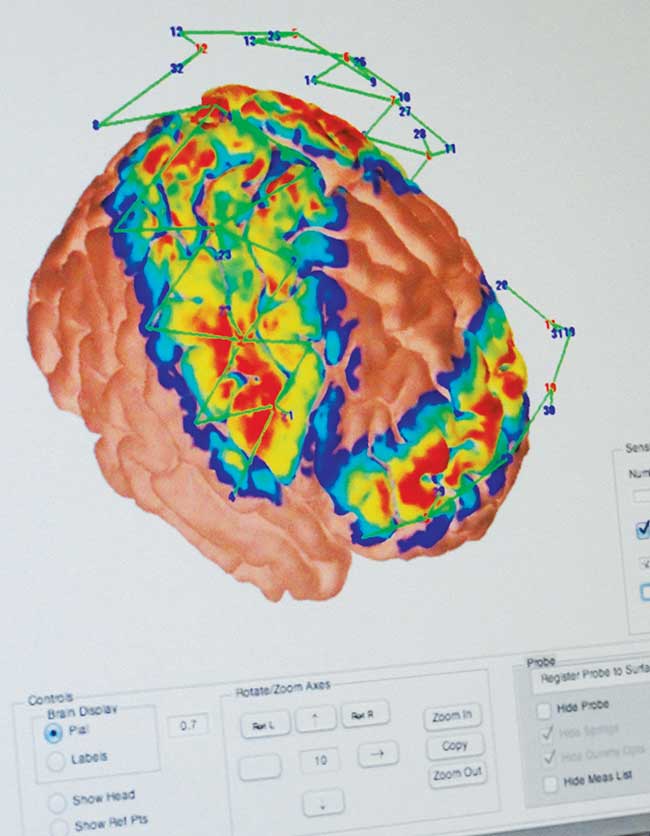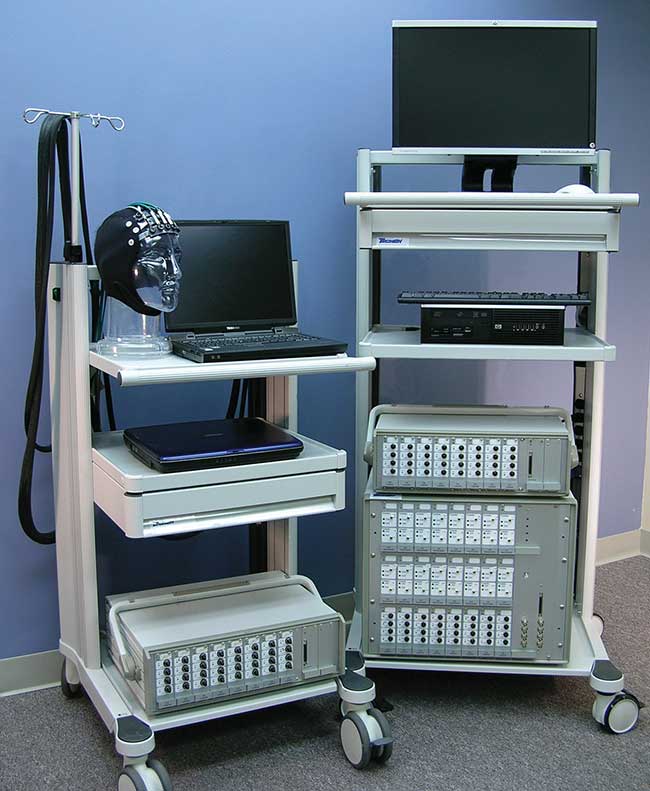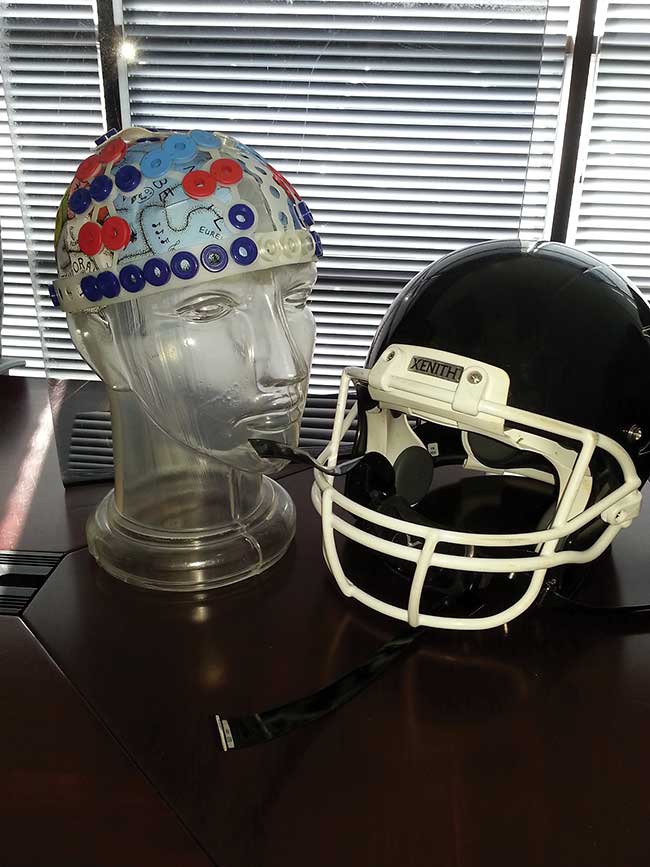
Near-Infrared Spectroscopy: Delving Deeper in the Brain
From four-channel systems for proof-of-principle measurements in humans, to studies of cognitive development and epilepsy, functional near-infrared spectroscopy is attracting interest worldwide.
ARTHUR DIMARTINO, TECHEN
As a functional brain monitoring and imaging technique, functional near-infrared spectroscopy (NIRS) has undergone a tremendous transformation. Over the past two decades, the technology has grown from bulky prototype instruments measuring one or two points on the head to sophisticated systems providing whole-brain coverage and real-time display and enabling an array of important applications, including applications in behavioral research, psychiatry, memory loss, and stroke and brain injury. In many cases, the technological developments have occurred alongside changes in the user base and the emergence of new applications, often — though by no means always — in response to those changes.
Proof-of-principle instruments for measuring brain activity
The modern era of NIRS began in the mid-1990s with a series of papers describing the technique. By outlining the fundamentals of NIRS and the ways in which it can be used to determine blood oxygenation status in subjects, these papers opened the door to noninvasive investigation of activity in the brain: one of the most widespread applications of the technique today. Study of brain activity with NIRS is possible because neural activity is coupled with an increase in oxygen consumption, which itself is accompanied by an increase in cerebral blood flow, and this can be monitored noninvasively by measuring the degree of oxygenation in the blood.
At first, investigators obtained NIRS measurements on one or two points on the head with simple prototype instruments developed in-house; using such home-built instruments is a standard approach among academic research groups engaged in technology development. It wasn’t long, though, before commercial instruments started appearing — in some cases designed in collaboration with the very research groups who were leaders in developing and applying NIRS.
TechEn’s experience, working with the Optics Division lab led by David Boas at Massachusetts General Hospital in Boston, is illustrative of the academic-industrial partnerships that have yielded many of the advancements in NIRS instruments currently on the market. Boas authored several papers that spurred development of NIRS for the study of brain activity, after finishing his doctorate in 1996. With the help of a graduate student, Andrew Siegel, they developed early NIRS instrumentation. But they found themselves faced with engineering challenges that required more resources to address them than they had in the lab at the time, leading to what became a 15-plus-year relationship with TechEn.
The earliest instruments served essentially as proof of principle, demonstrating multichannel monitoring with NIRS — first with four lasers and four detectors, and then with eight of each — and optimizing the instruments’ performance. These systems, like many of their successors, used continuous-wave laser emission. That is, they relied on a continuous beam of light and measured only the intensity of the light that emerged from the tissue, as opposed to also measuring the time it takes the photons to travel through the tissue, as with time- and frequency-domain techniques.
For TechEn, the use of continuous-wave proved more advantageous than expected, with its selection initially being driven by lower cost and greater flexibility with respect to where on the head sources and detectors could be placed. In the years to come, continuous-wave would prove tremendously useful as it enabled a range of applications — studies of concussion including cortical connectivity, for example, which look at bilateral or multiple areas of the brain — that few, if any, in the burgeoning NIRS community had anticipated (Figure 1).

Figure 1. Brainscape software enables localization of cortical functional activation from NIRS data. Courtesy of TechEn.
Challenges with head probes
Eventually, more channels — up to 32 low-power lasers and 32 detectors — were added to the NIRS technology. This development impacted NIRS measurements in two important ways: It offered both greater coverage of the head and overlapping measurements. The former of these enabled localization of neural activity and thus facilitated brain mapping applications of NIRS, where researchers worked to identify areas of the brain associated with particular tasks, such as working memory, motor activities or sensory functions. The latter proved integral in developing the ability to reconstruct, in three dimensions, images of changes in cerebral blood flow, and therefore of neural activity.
The continued development of the technology corresponded to the growth of a user community beyond the original developers of the technology, due at least in part to research collaborations established by researchers in the Boas lab, as well as in other labs worldwide. The new users included investigators who wanted to apply NIRS to the study of cognitive development in children, or to the study of psychiatric disorders. The technology proved especially useful for the former, as studying children is notoriously difficult with functional MRI, which necessitates that subjects remain immobile during scanning. NIRS doesn’t require that children sit still. In fact, it enables imaging while subjects are engaging their environments, which opens up whole new areas of investigation for the researchers using it.
In technology development, important advances in overall system design are often made possible by the introduction into the marketplace of improved components. For example, NIRS systems’ National Instruments data acquisition cards, which required converting the files from the National Instruments file format to a more flexible NIRS file format, were replaced with a custom control board using high-speed digital signal processors (DSP) for fast data acquisition. TechEn’s CW6 system, for instance, uses two high-density field-programmable gate arrays (FPGAs) and two high-speed digital signal processors, each with 3600 mega floating-point operations per second (MFLOPS) of floating-point performance. The result is high-speed data acquisition and display of up to 1,024 possible signals simultaneously in real time (Figure 2).

Figure 2. TechEn’s Techen CW6 systems support continuous-wave NIRS for research and brain mapping. Courtesy of TechEn.
As users expanded beyond the physicists and engineers who developed and adopted NIRS technology for their research, challenges with head-probe designs became more apparent. The head probe, which houses the laser light sources and detectors, might seem the least likely aspect of NIRS to present difficulties. However, as with EEG, it has proved very challenging over the years.
In March 2014, BioPhotonics highlighted some of the issues developers had encountered in designing probes for NIRS in the article “Building the Perfect Fiber Optic Probe.” Chief among these were two obstacles: hair and the contours of the head. Hair can present a problem because it can slip between the tip of the fiber and the scalp, perturbing the signal and negatively impacting the measurement. Similarly, the assorted ridges and slopes on the head make it difficult to maintain a snug fit between the probe and the scalp. If the head were a perfect sphere, researchers wouldn’t have this problem; all of the fibers in the probe would remain in contact with the scalp. Engineers and other system developers have addressed these challenges by tweaking the probe designs, and by incorporating right angle bends into the fibers to maintain better contact (Figure 3).

Figure 3. (a) Dense array cap. (b) Low-profile, lightweight optical fibers. (c) Head cap with fibers. Courtesy of TechEn.
Another challenge: the weight of the fibers themselves. Made of glass and often relatively long, the fibers can pull on the probe, shifting its position on the head and corrupting the measurements. Developers have come up with a variety of means to address this issue, including incorporating the sources and detectors into the probe itself and thus eliminating the need for fibers.
LED light sources and portability
NIRS technology’s forecast suggests even wider adoption, with an even broader and more diverse user base than exists today. This, in turn, will accelerate and drive the ongoing development of NIRS systems.
The shift toward a less technical user base has been accelerating over the past five or six years, as evidenced by the exponentially growing number of functional NIRS publications. At the same time, the biennial meeting of the Society for Functional Near-Infrared Spectroscopy, which will convene this month for the fourth time, has grown in attendance from its inaugural meeting in 2010 from approximately 150 to a worldwide audience approaching 350 researchers/attendees in 2016.
Amid this shift, two interrelated areas of development have come center stage. First, developers can incorporate LEDs and low-power lasers as light sources for the NIRS systems. This incorporation of lower-cost components helps drive down overall costs.
At the same time, developers are advancing ease of use and portability. Some systems already incorporate wireless technology, enabling greater movement for participants, including seniors walking and talking in studies of balance and memory, and children in school or at play in studies of ADHD. These are examples of applications where researchers want to be able to take measurements without essentially immobilizing the subjects. Another recent advancement is hyperscanning, which allows multiple subjects to interact while data about their experience is acquired. This is important for research in the study of social communication and in the study of autism, where the timely activation or differences in brain response may be significant.

Figure 4. NIRS has been used to study concussions. Courtesy of TechEn.
Developers are advancing many of these applications by making a wireless headband-based system using LEDs as light sources. TechEn’s prototype of this system is in beta testing and will be released next month. Software is being developed to move the field closer to a fully turnkey system for an ever-growing user base and a range of fascinating new medical applications.
The future for functional NIRS continues to be very promising, because ongoing innovations are advancing our understanding of cognitive issues and deficits. As a result, breakthrough applications are being introduced that help all age groups in diverse areas such as understanding learning styles in children, evaluating concussion in youth (Figure 4), monitoring epilepsy, and analyzing issues of balance and delaying memory loss in seniors. With the advent of lower-cost and more portable NIRS devices, unique opportunities will continue to emerge. From daily fitness trackers to continuous medical brain monitors, NIRS technology in everyday devices will matter, and will be transformative for years to come.
Meet the author
Arthur DiMartino is president of TechEn Inc. in Milford, Mass.; email: [email protected].
/Buyers_Guide/TechEn/c24630
Published: September 2016
Glossary
- near-infrared spectroscopy
- Near-infrared spectroscopy (NIRS) is a non-invasive analytical technique that uses the near-infrared region of the electromagnetic spectrum to study the absorption of light by molecules in a sample. This technique is commonly applied in fields such as chemistry, biology, medicine, and agriculture for qualitative and quantitative analysis of various substances.
Key features and principles of near-infrared spectroscopy include:
Near-infrared region: NIRS typically covers the spectral...
spectroscopyLasersBiophotonicsAmericasnear-infrared spectroscopyNIRStechencognitive developmentepilepsyoxygenationDavid BoasAndrew SiegeldiagnosticsArthur DiMartinoFeatures